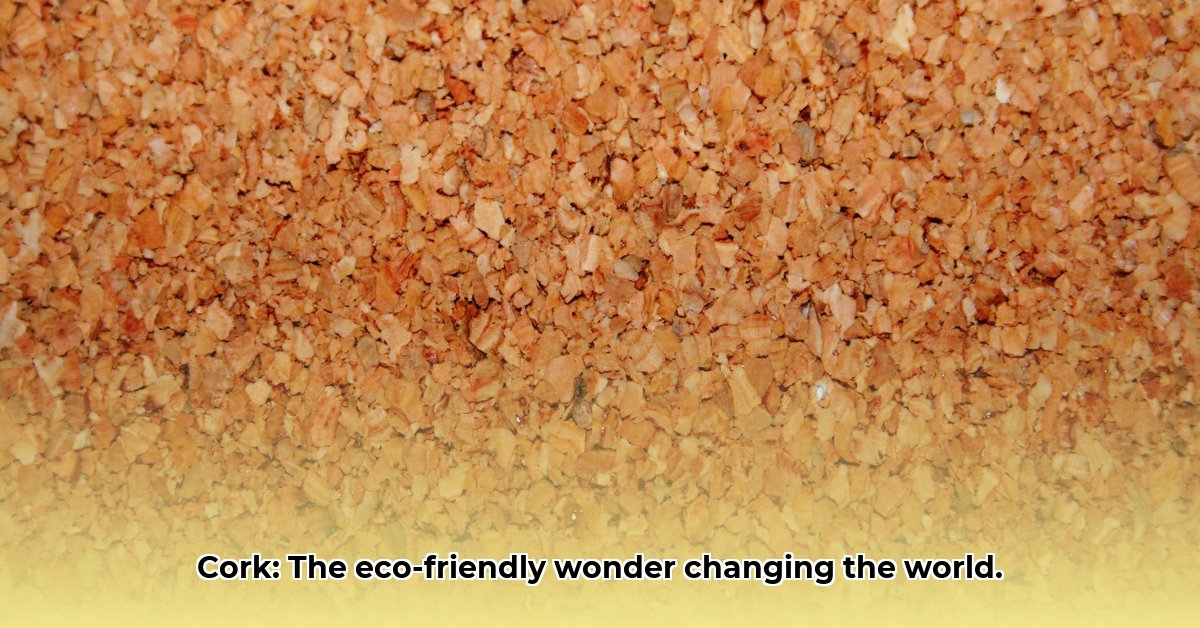Ever wonder what that little stopper in your wine bottle is really made of? It’s cork, a surprisingly versatile material with a fascinating story reaching back millennia. From its humble beginnings as a simple bottle plug, cork has evolved into a critical component in everything from building insulation to high-tech aerospace applications. This isn’t just any material, though; cork is a natural wonder, sustainably harvested and incredibly eco-friendly. We’ll explore how cork is made, why its unique properties make it so special, and how it is increasingly prevalent in modern industries. Learn more about sustainable water management here. Get ready to discover the amazing things cork can do!
What is Cork? Unveiling the Secrets of This Sustainable Material
Imagine popping open a bottle of your favorite wine, the satisfying pop echoing the centuries-old relationship between humans and cork. But what is cork, really? It’s so much more than just that little stopper sealing your merlot. It’s a remarkable, naturally occurring material, a testament to sustainable practices, and a surprisingly versatile component in countless products we use every day. Let’s delve into the fascinating world of cork and discover its sustainable secrets.
Harvesting Nature’s Gift: A Sustainable Symphony of Renewable Resources
Cork isn’t just harvested; it’s carefully cultivated and nurtured. Unlike trees felled for lumber, the cork oak (Quercus suber) benefits from a unique harvesting process that extends its life. Imagine skilled workers, their movements precise and practiced, carefully stripping the outer bark from the tree. This doesn’t kill the tree; it’s more akin to carefully peeling a fruit. The outer layer, the cork, regenerates completely, allowing the tree to live for well over two centuries, with harvests occurring roughly every nine years. These ancient trees, some living for hundreds of years, are living, breathing testaments to sustainable resource management. It’s a mutually beneficial relationship, ensuring cork forests continue to thrive.
The Amazing Properties of Cork: Lightweight Champion and Versatile Performer
This seemingly simple material boasts an impressive array of unique properties stemming from its distinct cellular structure. Millions of tiny air-filled pockets are trapped within a flexible, waterproof matrix, giving cork its signature lightweight feel, surprising strength, and remarkable elasticity. This unique combination of features makes it remarkably resistant to liquids and gases, while also providing excellent insulation against heat, sound, and vibration. It’s truly a multi-talented material, showcasing incredible versatility across various applications.
Think beyond that wine bottle. Cork’s insulating properties make it a star player in construction, offering superior thermal and acoustic insulation for homes and buildings, significantly reducing energy consumption. Its resilience and flexibility shine in the fashion industry, shaping comfortable footwear, stylish handbags, and other accessories. Even the aerospace industry has found uses for this remarkable material, thanks to its lightweight strength and vibration-dampening capabilities, reducing noise and improving passenger comfort. The automotive industry uses cork in interior components, further enhancing vehicle comfort and sustainability. Due to its unique cellular structure and composition, cork provides exceptional insulation, often outperforming many synthetic alternatives.
To recap, here’s why cork stands out:
- Renewable Harvest: The cork oak tree isn’t felled; its bark regenerates completely, allowing for multiple harvests throughout its long lifespan.
- Exceptional Insulation: Its cellular structure provides excellent thermal and acoustic insulation, contributing to energy efficiency.
- Versatile Applications: From wine stoppers to aerospace components, cork adapts to diverse needs, showcasing its adaptability.
Cork and the Environment: A Symbiotic Relationship for Environmental Protection
The sustainability of cork isn’t just a marketing claim; it’s a fundamental environmental benefit. The non-destructive harvesting of cork bark supports thriving cork oak forests, which are biodiversity hotspots, teeming with life, including endangered species like the Iberian lynx. These forests act as crucial carbon sinks, actively absorbing carbon dioxide from the atmosphere, mitigating climate change. They also play a vital role in combating desertification, stabilizing the soil and preventing erosion in vulnerable regions. Moreover, the production of cork is a naturally low-impact and readily biodegradable process, minimizing waste and environmental harm. When compared to synthetic alternatives, cork offers a significantly smaller environmental footprint, making it a top choice for environmentally conscious consumers and industries, promoting sustainable material solutions globally.
Challenges and the Future of Cork: Innovations on the Horizon for Material Science
Despite its many advantages, the cork industry faces ongoing challenges, including concerns surrounding the natural variation in cork quality and increasing competition from synthetic materials. However, these challenges have spurred significant innovation within the industry. Researchers are actively developing solutions to improve cork quality and expand its applications. Scientists are working on refining harvesting techniques to optimize bark regeneration, creating more consistent products through advanced processing methods, and even exploring the potential of biotechnology to enhance cork’s inherent properties.
There’s also a growing emphasis on developing innovative composite materials that combine cork’s unique properties with other sustainable materials to enhance its performance in specific applications. These efforts are aimed at pushing the boundaries of what cork can do, making it even more versatile and competitive in a global market. Improving logistics and processing methods to further reduce the overall environmental impact are also key areas of focus. All of these efforts are aimed at creating a future for cork that is brighter than ever, fueled by ongoing commitment to sustainability, quality, and material innovation.
| Challenge | Current Solutions | Potential Future Directions |
|---|---|---|
| Inconsistent Cork Quality | Improved harvesting techniques, stricter quality control during processing | Advanced sensor technology during harvest, precision processing methods, biotechnological enhancements |
| Competition from Synthetics | Emphasizing cork’s unique properties (sustainability, biodegradability) | Development of novel composite materials offering superior performance and sustainability |
| Transportation & Processing | Optimized logistics, increased use of renewable energy in processing facilities | Localized processing to reduce transportation impact, use of sustainable and recyclable packaging materials |
Key Considerations:
* Implementing improved quality control measures can significantly minimize inconsistency.
* The development and utilization of composite materials may greatly expand potential applications.
* Promoting localized processing can further enhance overall sustainability.
What is cork? It’s more than just a material; it’s a testament to sustainability, innovation, and the remarkable potential of nature’s gifts. The journey of cork, from the ancient cork oak forests to our modern applications, showcases a sustainable approach that can inspire industries worldwide. The future of cork is promising, with ongoing research and innovation paving the way for even greater contributions to a greener tomorrow.
How to Minimize the Environmental Impact of Cork Production for a Greener Tomorrow
Cork, a marvel of nature, serves as a compelling case study in sustainable materials. But how can we ensure its production remains environmentally responsible and contributes to a greener future for generations to come? Let’s explore strategies to minimize its impact and further enhance its already impressive eco-friendly profile.
Understanding Cork’s Origins for Sustainability
Cork originates from the bark of the cork oak tree (Quercus suber). These trees, primarily found in the Mediterranean region, are uniquely adapted to sustainable harvesting. The harvesting process doesn’t kill the tree; instead, the bark is carefully stripped every nine years, stimulating new growth and extending the tree’s lifespan. This sustainable harvesting method is a cornerstone of cork’s environmental narrative.
The Cork-Harvesting Process: A Sustainable Practice and Environmental Conservation
The traditional method of harvesting cork relies on skillful manual labor. Specially trained workers carefully strip the bark by hand, a process requiring years of experience to minimize damage to the trees. This meticulous approach preserves forest health, maximizes tree lifespan, and ensures continued cork production. This method of careful harvesting promotes longevity and vitality in cork tree forests.
Cork’s Environmental Advantages and Eco-Friendly Qualities
Cork possesses exceptional properties: it’s lightweight, buoyant, elastic, and an excellent insulator. These attributes make it a versatile material used in everything from wine stoppers to building insulation and high-performance composites. More importantly, it’s biodegradable, renewable, and sequesters carbon dioxide during the growth of the cork oak tree. This makes its use an environmentally responsible alternative to many less sustainable materials, promoting sustainability and reducing environmental impact.
How to Minimize the Environmental Impact of Cork Production: a Step-by-Step Guide
-
Sustainable Forestry Practices: Strict adherence to sustainable harvesting techniques is essential. This involves ensuring proper spacing of trees, careful stripping of the bark without causing tree damage, and responsible replanting programs to maintain and expand forest health.
-
Reduced Chemical Use: Minimizing the use of chemicals during the processing of cork is crucial to protect both the environment and the health of workers. The development and adoption of innovative, eco-friendly treatments are vital to further reduce the environmental footprint.
-
Waste Reduction & Upcycling: Cork production inevitably generates some waste. Implementing innovative upcycling methodologies to transform cork scraps into valuable new products minimizes waste and reduces the need for virgin materials.
-
Transportation Optimization: Reducing the distance finished cork products travel is key minimizing transportation emissions and reliance on fossil fuels. Promoting local manufacturing and distribution networks reduces the carbon footprint associated with transportation.
Following these steps has shown a potential to reduce the carbon footprint of cork production significantly.
Challenges and Future Innovations in Cork Production and Sustainable Forestry
While cork offers numerous environmental advantages, challenges remain. Maintaining steady production requires careful forest management, and competition from synthetic materials creates ongoing pressure on the industry. However, ongoing research into new applications, like high-performance cork composites, and advancements in processing techniques are ensuring cork’s continued competitiveness and sustainability in the future.
Cork’s Role in a Circular Economy and
- Jerry McSorley Teammates: Unveiling the Truth - July 17, 2025
- Uncover Marty McSorley’s Hockey Legacy: A Complex Career - July 17, 2025
- Jerry McSorley Post-Hockey Success: New Life, New Ventures - July 17, 2025















